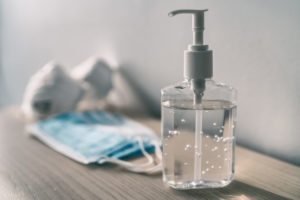Automating resident care equipment cleaning and disinfection: The new paradigm
Long-term care facilities, rehabilitation facilities, hospitals and other healthcare providers share a common objective: keep patient care equipment clean and infection free. Increasing quality metrics, lower budgets and staff shortages are just some of the business pressures forcing healthcare organizations to do more with less. While costs must come down, standards for disinfecting medical equipment and cleaning are going up—not as a choice, but a requirement.
Wheelchairs, commodes, carts, over-bed tables, and other high-touch items are prime candidates to retain pathogens from patients, visitors or staff. It is very difficult to keep equipment clean and infection free in the available time and at the least costs using manual methods. When manual methods are used, cleaning and disinfection will vary from person to person on any given day. Equipment mobility also makes it difficult to keep track of these tasks and often times may have different people responsible for cleaning and disinfection, each having their own procedure from one day to the next.
Unfortunately, manually cleaning wheelchairs, commodes and other patient care equipment can be thought of as an undervalued function. Casual wiping on minimal surfaces and inconsistent frequency only serve to minimize the importance of the job. To work within a lower budget, utilize staff more efficiently and at the same time raise the standards for infection prevention, a consistent dependable automated process is required.
Automated cleaning of patient care equipment is not a new technology; its debut was about 20 years ago. Like many new technologies it had its share of problems. But, slowly it improved and today is used throughout healthcare markets. During those 20 years, healthcare facilities have moved away from that once-a-year or perhaps twice-a-year “Wheelchair Cleaning Day.” Once or twice a year is no longer adequate or acceptable.
Today it is recognized that wheelchairs like so many other types of mobility equipment are touch points for spreading infections. In a similar way, the slow adoption to wash hands thoroughly is being repeated with mobile equipment. The potential of spreading infections in different areas of the facility by contact with patient, staff or visitor is just as likely with equipment as it is with hands.
The Becker’s Infection Control & Clinical Quality article “Implementing and Sustaining Best Practices in Mobile Equipment Disinfection” states, “One area that is often overlooked, but presents a significant opportunity to reduce infection risk, is the disinfection of mobile equipment. Mobile equipment, such as wheelchairs, IV poles and computers/workstations on wheels, are touched thousands of times every day by patients, visitors and staff. As this occurs, pathogens can spread from the individual to the equipment and vice versa, and bacteria spreads from one area of the hospital to another. Numerous studies have shown that hospital surfaces and frequently used medical equipment become contaminated by a variety of pathogenic and nonpathogenic organisms. Proper decontamination of mobile equipment, therefore, plays an important role in stopping the spread of HAIs.”
An American Journal of Infection Control article notes the challenge of disinfecting wheelchairs: “Health care-associated infections (HAIs) are prevalent and affect between 1 and 10 and 1 in 25 patients in both U.S. and Canadian Hospitals. Current guidelines, however, do not provide specific instructions on the optimal processes for tracking, cleaning, and disinfecting more complicated hospital equipment, such as wheelchairs.”
It’s easy to understand why wheelchairs are the focus for an automated cleaning and disinfection system. A standard wheelchair has about 3,000 inches of surfaces of which 1,500 inches are viewable for cleaning and the other 1,500 are hidden from view. Thorough manual cleaning can take well over 20 minutes per wheelchair. What makes matters worse, these hidden areas can become a place for pathogens to take up residency particularly if liquids or food are on the chair for an extended period of time.
Historically, many disinfectants have required contact times of five to 10 minutes, and people just didn’t want to wait that long. Today, disinfectant contact times have been significantly reduced.
In addition, newer technologies can provide automated washing, rinsing and high-level disinfection using Ultra-Violet (UV) can be done in six minutes. While the automated process to clean and disinfect care equipment is consistent for one or 100 pieces of equipment, there are many other benefits. An automated process elevates the value of this function resulting in greater employee satisfaction, morale and improved staff utilization, while emphasizing the importance of thorough cleaning and proper disinfection.
From a financial and staff utilization perspective, labor savings is significant when you compare manual labor time to automation. Automation is the right tool to do the tedious, repetitive, mundane job and it frees up the operator to do something which has greater employee satisfaction, efficiency and increased productivity.
In addition to the obvious benefits stated above; there is minimal chemical handling, no stooping or bending down to reach more difficult areas of the equipment, no worrying about chemical solution ratios for disinfection and measuring the process is easy. All and all, newer cleaning and disinfection technologies are a major win for residents, employees, visitors and the facility.
Karl Soderquist is President of The HUBSCRUB Company, Manchester, N.H. He is affiliated with the Association for the Healthcare Environment (AHE), National Association of Healthcare Transport Management (NAHTM) and the American Society for Healthcare Engineering (ASHE). He can be reached at 603-624-4243.
I Advance Senior Care is the industry-leading source for practical, in-depth, business-building, and resident care information for owners, executives, administrators, and directors of nursing at assisted living communities, skilled nursing facilities, post-acute facilities, and continuing care retirement communities. The I Advance Senior Care editorial team and industry experts provide market analysis, strategic direction, policy commentary, clinical best-practices, business management, and technology breakthroughs.
I Advance Senior Care is part of the Institute for the Advancement of Senior Care and published by Plain-English Health Care.
Related Articles
Topics: Articles , Facility management , Infection control , Rehabilitation , Resident Care , Technology & IT










